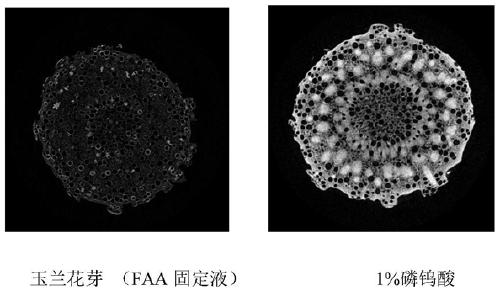Method for enhancing contrast of microscopic CT plant sample
A contrast and plant technology, applied in the biological field, can solve problems such as difficult structure edges, few researches, and small image contrast
- Summary
- Abstract
- Description
- Claims
- Application Information
AI Technical Summary
Problems solved by technology
Method used
Image
Examples
Embodiment Construction
[0034] The experimental methods used in the following examples are conventional methods unless otherwise specified.
[0035] The materials and reagents used in the following examples can be obtained from commercial sources unless otherwise specified.
[0036] Dissolve phosphotungstic acid in FAA fixative solution to obtain a phosphotungstic acid solution with a mass concentration of 1 to 10%, wherein the composition of FAA fixative solution is as follows: FAA fixative solution (100ml): 90ml of 50% ethanol aqueous solution, 5ml of glacial acetic acid , formaldehyde 5ml.
[0037] The following examples were subjected to carbon dioxide critical point drying in a critical point dryer (CPD300, Leica).
[0038] 1. Magnolia flower buds were put into FAA fixative solution and 1% phosphotungstic acid solution respectively, turned upside down several times to remove air bubbles, until the sample sank into the solution, dyed and fixed at 4°C for 2 days, and then used 70%, 80%, 90% and ...
PUM
 Login to View More
Login to View More Abstract
Description
Claims
Application Information
 Login to View More
Login to View More - R&D
- Intellectual Property
- Life Sciences
- Materials
- Tech Scout
- Unparalleled Data Quality
- Higher Quality Content
- 60% Fewer Hallucinations
Browse by: Latest US Patents, China's latest patents, Technical Efficacy Thesaurus, Application Domain, Technology Topic, Popular Technical Reports.
© 2025 PatSnap. All rights reserved.Legal|Privacy policy|Modern Slavery Act Transparency Statement|Sitemap|About US| Contact US: help@patsnap.com



